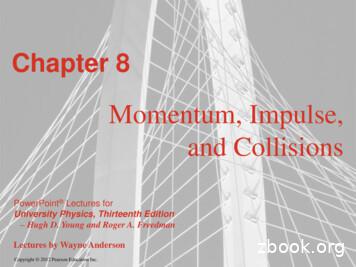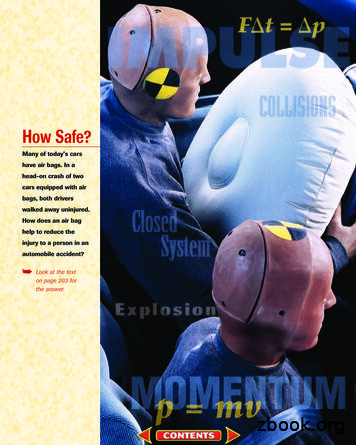Chapter 8 Momentum And Impulse 1 Momentum And Impulse
XdP Fext M acm dtNote:If the net external force is zero, then the acceleration of the center-of-mass is zero(i.e., acm 0). Likewise, if the net external force is zero, then the total momentumP must be conserved, (i.e., dP /dt 0).6Rocket PropulsionUsing conservation of momentum, we can write the following:Momentum Initial Momentum FinalM (t) v M (t t) (v v) m(v vex )0 (M (t t) M (t)) v M (t t) v v m vex mHowever, M (t t) M (t) M m, so, the first and third terms canceland we can rewrite the previous equation as:0 M (t t) v vex m14(10)
At this point, we can go in two different directions with equation 10. We candevelop the thrust equation, or the velocity equation. Let’s start with the thrustequation.The Thrust EquationWe can make the substitution in Eq. 10 where we divide everything by t, andtake the limit as t 0. Then, we have:0 M (t)dvdm vexdtdtForce on the rocket vexordm MadtMwheredvdm vexdtdtThrust vexdmdt(11)The reason that my “sign” convention is different from the book (thrust vex dm/dt)is because I chose dm 0, while the book chose dm 0.Equation 10 describes Newton’s 2nd law for a rocket in space without any otherexternal forces. If the rocket is situated on a launch pad, then you would have toadd the gravitational pull of the earth. Near the earth’s surface, we would havethe following equation:Force on the rocket vexdm Mg Madt(12)The Velocity EquationStarting with Eq. 10, we make the following substitution: m M , and takethe limit as t 0, and gathering the “mass” terms on one side of the equationwe have:Z vZ MfdMdMdv vex dv vexMMvoMiv vo vex n m o(the velocity equation)m15
Ex. 61A 70-kg astronaut floating in space in a 110-kg MMU (manned maneuvering unit) experiences an acceleration of 0.029 m/s2 when he fires oneof the MMU’s thrusters. a) If the speed of the escaping N2 gas relativeto the astronaut is 490 m/s, how much gas is used by the thruster in5.0 s? b) What is the thrust of the thruster?Other Homework ProblemsEx. 82Two identical masses are released from rest in a smooth hemisphericalbowl of radius R from the positions shown in Fig. P8.82. Ignorefriction between the masses and the surface of the bowl. If the massesstick together when they collide, how high above the bottom of thebowl will they go after colliding?16
Exercise A proton moving with speed vA1 in the x-direction makes an elastic,off-center collision with an identical proton originally at rest. Afterimpact, the first proton moves with speed vA2 in the first quadrant atan angle α with the x-axis, and the second moves with speed vB2 in thefourth quadrant at an angle β with the x-axis (Fig. 8.13). (a) Write theequations expressing conservation of linear momentum in the x- andy-directions. (b) Square the equations from part (a) and add them.(c) Now introduce the fact that the collision is elastic. (d) Prove thatα β π/2. (You have shown that this equation is obeyed in anyelastic, off-center collision between objects of equal mass when an objectis initially at rest.)Ex. 96 A 20.0 kg projectile is fired at an angle of 60.0 above the horizontalwith a speed of 80.0 m/s. At the highest point of its trajectory, theprojectile explodes into two fragments with equal mass, one of whichfalls vertically with zero initial speed. Ignore air resistance. (a) Howfar from the point of firing does the other fragment strike if the terrainis level? (b) How much energy is released during the explosion?17
100 Mm/s10 Msec AM-Beam max400 Mm/sDelta V Nomogram v01300 Mm/s50 Mm/s5 Msec H- Fe Fusion max40 Mm/s4 Msec30 Mm/s3 Msec H- He Fusion max20 Mm/s2 MsecLay straightedge between any two known valuesand read the unknown value where edge crosses the scale.dV Ve.ln(R)In the delta V scale:(no way) 25Hohman are minimum-delta-V, maximum-duration impulse trajectories.(dV 3xEv) 20I-3 are impulse trajectories near the transition between delta-V levelsfor high impulse trajectories and low brachistochrone trajectories.15(it is a hyperbolic solar escape orbit plus 30 km/s).I-2 is an impulse trajectory in-between Hohman and I-3(close to limits on the possible) 10(it is equivalent to an elliptical orbit from Mercury to Pluto)9Winchell Chung (Nyrath the Nearly dV 2xEv) 7.4200 Mm/s100 Mm/s50 Mm/s40 Mm/s30 Mm/s10 Mm/sIC-Fusion max1 Msec ORION max20 Mm/sHe3-D FusionAM-Plasma (H2)10 Mm/s5 Mm/s500 ksec NSWR 90% UTB4 Mm/s400 ksec3 Mm/s5 Mm/s300 ksec4 Mm/s3 Mm/s2 Mm/s1 Mm/s200 ksecH-B Fusion100 ksec AM-Plasma (H2O)87.5%85.7%Earth-Jupiter 1g brachistochrone683.3%Earth-Ceres 1g brachistochrone580%(limit for economical cargo ship) 475%3.3370%Earth-Saturn 0.1g brachistochroneEarth-Mercury 1g brachistochroneEarth-Mars 1g brachistochroneEarth-Jupiter 0.1g brachistochroneEarth-Ceres 0.1g brachistochrone1 Mm/sEarth-Saturn 0.01g brachistochroneEarth-Mercury 0.1g brachistochroneEarth-Mars 0.1g brachistochroneEarth-Jupiter 0.01g brachistochrone366.6%(dV Ev) 2.763.2%Earth-Venus 0.1g brachistochrone2.560%250%1.67(dV Ev/2) 1.6440%500 km/s50 ksec400 km/s400 km/s40 ksec300 km/s300 km/s30 ksec VASIMR (high gear)200 km/s20 ksecMPDEarth-Mercury 0.01g brachistochroneEarth-Mars 0.01g brachistochroneEarth-Venus 0.01g brachistochroneEarth-Luna 1g brachistochrone200 km/sMini-Mag Orion100 km/sIonVASIMR (med gear)ACMF10 ksec NTR-GAS maxORION Fusion/J x B ElectricNSWR 20% UTB50 km/s40 km/sEarth-Jupiter I-3Earth-Mercury I-3/Earth-Saturn I-3Earth-VenusI-3Earth-Mars I-3/Earth-CeresI-3Earth-Mercury I-2/Earth-Jupiter I-2Earth-Venus I-2Earth-SaturnI-2Earth-Mars I-2Earth-Ceres I-2Earth-Uranus Hohman/Earth-Neptune Hohman30 km/s1.5Earth-Pluto Hohman33.3%20 km/s50 km/s5 ksecNTR-GAS-Open 2nd Gen40 km/s4 ksecColl. EStatic/Meta He*/ORION Fiss.Laser ThermalNTR-GAS-Open (H2)30 km/s3 ksecVASIMR (low gear)/Mass Driver2 ksecAM-Gas maxArcJet/D-T Fusion/Meta He IV-ANTR-LIQUID/NTR-GAS-ClosedE-T MITEE/NTR-GAS-CoaxialNTR-LIQUID max1 ksec90%88.9%72 Mm/s500 km/s10 km/s93.3%Earth-Saturn 1g brachistochroneEarth-Ceres 0.01g brachistochrone/Solar Escape Velocity20 km/s95%Earth-Venus 1g brachistochroneAIM100 km/s96%10 km/sEarth-Mercury HohmanEarth-Saturn HohmanEarth-Jupiter Hohman1.4330%Earth-Ceres HohmanEarth Liftoff5 km/s4 km/sMonatomic-H MITEE3 km/sNTR-SOLID maxAM-SOLID maxBasic MITEE/NTR-SOLID-PBed 2 km/sSolar Moth/LANTR (Nerva mode)NTR-SOLID (H2)Earth-Mars HohmanEarth-Venus HohmanEarth-Luna HohmanMars LiftoffMercury Liftoff1.25Titan Liftoff20%Io, Ganymede LiftoffLuna, Callisto LiftoffEuropa LiftoffNTR-SOLID (CH4)/LANTR (LOX mode)1 km/s4 km/s500 sec NTR-SOLID (NH3)Chemical MAX400 sec NTR-SOLID (H2O)3 km/sNTR-SOLID (CO2)500 m/s300 sec Single Saturn-V F-1400 m/s5 km/sNTR-SOLID (CO or N2)300 m/s1.11810%Propellant Fraction1.111100 m/sMass Ratio100 sec200 m/sDelta V (m/s)1 km/s200 secSpecific Impulse (sec)Exhaust Velocity (m/s)2 km/s
19
1.2 Relationship Between Kinetic Energy and Momentum As you can see from the above equation, the P F (the net force) forms a rela-tionship between the change in momentum and the change in kinetic energy. The relationship between the kinetic energy (1 2 mv 2) and the momentum (mv) is: K p2
CHAPTER 3 MOMENTUM AND IMPULSE prepared by Yew Sze Ling@Fiona, KML 2 3.1 Momentum and Impulse Momentum The linear momentum (or "momentum" for short) of an object is defined as the product of its mass and its velocity. p mv & & SI unit of momentum: kgms-1 or Ns Momentum is vector quantity that has the same direction as the velocity.
1. Impulse and Momentum: You should understand impulse and linear momentum so you can: a. Relate mass, velocity, and linear momentum for a moving body, and calculate the total linear momentum of a system of bodies. Just use the good old momentum equation. b. Relate impulse to the change in linear momentum and the average force acting on a body.
Impulse and momentum The impulse of a force is the product of the force and the time interval during which it acts. On a graph of F x versus time, the impulse is equal to the area under the curve, as shown in figure to the right. Impulse-momentum theorem: The change in momentum of a particle during a time interval
Momentum Impulse Newton Graphing Impulse The simple definition for impulse is that it is a change in momentum. If an object’s velocity changes, there is a change in momentum, so there must be an impulse We assume that you are not going to change the mass of an object. Δp m Δv Δp impulse (change
Lecture L10 - Angular Impulse and Momentum for a Particle In addition to the equations of linear impulse and momentum considered in the previous lecture, there is a parallel set of equations that relate the angular impulse and momentum. Angular Momentum We consider a particle of mass m,
1, which expresses the change in momentum of the tennis ball. Thus, the impulse on an object is equal to the change in its mo mentum. Impulse-Momentum Theorem F t p 2 p 1 This equation is called the impulse-momentum theorem.The impulse on an object is equal to the chan
6.1 Momentum and Impulse ! Impulse – In the initial seconds of a collision, there is an impulse force on the object. ! This force is defined as the change in linear momentum: ! In order to change the momentum of an object, a force must be applied. ! The time rate of change of momentum of
Physics 101: Lecture 9, Pg 3 Momentum and Impulse Momentum p mv »Momentum is a VECTOR Impulse I FDt » Impulse is just the























